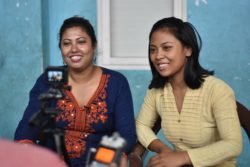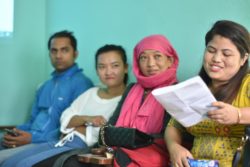Using the CARAN manual beyond AMR
University of Leeds PhD candidate Max Nawrath shares his experience of using the CARAN manual to create a participatory video project exploring local relationships with nature. Based in the Kathmandu Valley, Nepal this project worked in collaboration with HERDinternational and utilised many of the community engagement activities developed via the CARAN study.
Green cities, healthy cities: how nature can help us tackling the rising burden of non-communicable diseases (NCDs)
Throughout the world, substantial gains have been achieved in advancing health and living standards during the last century. This progress is now ‘threatened by crises of our own creation’, including the rise of non-communicable diseases (NCDs) such as heart disease, stroke or diabetes, which is seen by many as one of the major global challenges of our time. The main causes of NCDs are fairly well known, and are in part related to unhealthy diets and physical inactivity.
Driven to a great extent by the increasing surge of people into cities, especially in least developed countries, NCDs do now outweigh the impact of infectious diseases even in the poorer parts of the world. We understand the reasons for the rise in NCDs and have a pretty clear understanding of what we can do to avert them. One notion, fairly obvious perhaps – is to make cities more healthy places to live in.
Over the last decades, a growing body of evidence has pointed out the multiple benefits that green spaces can provide to cities, including the reduction of temperatures and pollution, carbon storage, supporting urban biodiversity and providing physical and mental health benefits to urban residents.
These health benefits are increasingly being acknowledged. The World Health Organization, for instance, recommends cities to provide their inhabitants with at least nine square meters green space per inhabitant. Many wealthy cities across the globe are implementing such policies – but what about less advantaged cities in the Global South which experience rapid, uncontrolled growth?
Kathmandu, the capital of Nepal, is such a city. From being a small town in the 1970s, it has transformed into a bustling metropolis of 2.5 million on the foothills of the Himalayas today. For centuries, a large part of the city area consisted of paddy fields and pastures. Today, these green spaces are disappearing rapidly to make way for the ever-increasing urban population, and with them perish the many benefits green spaces provide for people’s health. Alongside, not surprisingly, the city faces a burgeoning burden of NCDs, dominated by hypertension and diabetes.
 In summer 2019, I set out for Kathmandu to find out what local residents think about the city’s disappearing green spaces. By doing so, I hoped to understand the benefits people obtain from nature, and how the natural world provides these benefits. Ultimately, this knowledge will contribute to understanding how we can use green spaces for creating more liveable and healthy cities, especially in urbanising areas.
In summer 2019, I set out for Kathmandu to find out what local residents think about the city’s disappearing green spaces. By doing so, I hoped to understand the benefits people obtain from nature, and how the natural world provides these benefits. Ultimately, this knowledge will contribute to understanding how we can use green spaces for creating more liveable and healthy cities, especially in urbanising areas.
I used participatory video, which is a technique that encourages people to create their own film. The idea behind this is that making a video is easy and accessible, and is a great way for people to express their ideas and perceptions. Fortunately, I was well-equipped for applying this research method, as I was provided with an excellent manual for conducting participatory video research in Nepal developed by the Community Arts Against Antibiotic Resistance in Nepal (CARAN) Project – a collaboration between the University of Leeds in the UK and HERD International, one of the major public health NGOs in Kathmandu. With a little tweaking, it was quite straightforward to modify the CARAN manual for my own research.
I wanted to hear the stories people in Kathmandu have to tell about their personal relationships with green spaces. Together with Ashim Shrestha and Jyoti Mandal from HERD International, we asked residents from a slum settlement (Bansighat) and a better-off neighbourhood (Jorpati) to partner with us. We formed two film-making groups. After learning basic film-making skills and how to use video equipment through a series of workshops, we helped the participants in developing their own shooting scripts. Finally, the groups headed out to shoot their films.
Based on a preliminary analysis of the data, the stories indicated that both poorer and better-off residents perceived multiple benefits of urban green spaces. Both groups mentioned that plants and animal in the city had religious values. In Hinduism, which is the dominant faith in Kathmandu, some plant and a nimal species such as cows, monkeys or specific tree species are considered sacred, and contribute to people’s well-being because of their cultural importance. Additionally, most residents, poor or wealthy, mentioned that nature makes the city more beautiful and that green areas provide space for people to exercise, release stress and socialise. When it came to more utilitarian forms of relating to green spaces, however, poorer and wealthier residents mentioned different benefits. Slum dwellers discussed having spaces for keeping livestock or to maintain a small kitchen garden. Such urban farming practices may increase people’s food security and are a source of extra income, especially for disadvantaged groups. In contrast, better-off residents discussed more how green spaces can mitigate the harmful effects of flooding and air pollution, both daunting challenges in Kathmandu.
nimal species such as cows, monkeys or specific tree species are considered sacred, and contribute to people’s well-being because of their cultural importance. Additionally, most residents, poor or wealthy, mentioned that nature makes the city more beautiful and that green areas provide space for people to exercise, release stress and socialise. When it came to more utilitarian forms of relating to green spaces, however, poorer and wealthier residents mentioned different benefits. Slum dwellers discussed having spaces for keeping livestock or to maintain a small kitchen garden. Such urban farming practices may increase people’s food security and are a source of extra income, especially for disadvantaged groups. In contrast, better-off residents discussed more how green spaces can mitigate the harmful effects of flooding and air pollution, both daunting challenges in Kathmandu.

The stories indicate that prior to any policy action towards sustainable urban development in urbanising cities, it may be necessary to assess local residents’ perceptions of the benefits of green spaces.
Max is funded by a NERC DTP Spheres scholarship and works together with Martin Dallimer from the Sustainability Research Institute, University of Leeds and Helen Elsey from the Department of Health Sciences, University of York.
